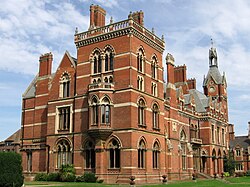
Newark and Sherwood is a local government district and is the largest district in Nottinghamshire, England. The district was formed on 1 April 1974, by a merger of the municipal borough of Newark with Newark Rural District and Southwell Rural District.

This is a list of halls of residence on the various campuses of the University of Nottingham in Nottingham, England.

Haddon Hall is an English country house on the River Wye near Bakewell, Derbyshire, a former seat of the Dukes of Rutland. It is the home of Lord Edward Manners and his family. In form a medieval manor house, it has been described as "the most complete and most interesting house of [its] period". The origins of the hall are from the 11th century, with additions at various stages between the 13th and the 17th centuries, latterly in the Tudor style.

Southwell is a minster and market town in the district of Newark and Sherwood in Nottinghamshire, England. It is home to the grade-I listed Southwell Minster, the cathedral of the Anglican Diocese of Southwell and Nottingham. The population of the town was recorded at 7,558 in the 2021 Census. The town is on the River Greet and is located geographically 9 miles (14 km) west of Newark on Trent, 15 miles (24 km) north-east of Nottingham, 13 miles (21 km) south-east of Mansfield and 22 miles (35 km) south-east of Worksop.
Averham is a village and civil parish in the Newark and Sherwood district of Nottinghamshire, England. According to the 2001 census it had a population of 187, increasing to 294 at the 2011 census. The village is just west of Newark-on-Trent. Staythorpe Power Station is south-west of the village.
Upton is a small village in Nottinghamshire, England, 2 miles (3.2 km) east of Southwell, 5 miles (8.0 km) west of Newark and 3 miles (4.8 km) south of Hockerton; it lies on the A612 Nottingham-Newark road. In 1889, the village was described as sitting on a bend in the main road, "on the summit of a hill which commands a fine view of the Trent Valley.... The church, which is a prominent feature in the landscape, has a substantial Perpendicular tower crowned by eight pinnacles, and having in the centre a lofty master pinnacle which rises above its neighbours, and so adds materially to the effect."
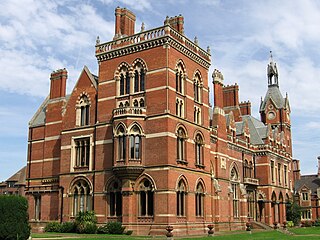
Kelham is a small village and civil parish in Nottinghamshire about 3 miles (4.8 km) northwest of Newark on a bend in the A617 road near its crossing of the River Trent. The population of the civil parish taken at the 2011 census was 207.
Robert Sutton, 1st Baron Lexinton was a Royalist MP in 1625 and 1640.
The Society of the Sacred Mission (SSM), with the associated Company of the Sacred Mission, is an Anglican religious order founded in 1893 by Father Herbert Kelly, envisaged such that "members of the Society share a common life of prayer and fellowship in a variety of educational, pastoral and community activities". Its motto is Ad gloriam Dei in eius voluntate.

The A617 road runs through the northern East Midlands, England, between Newark-on-Trent and Chesterfield.

Eakring is a village and civil parish in the Newark and Sherwood district of Nottinghamshire, England. Its population at the 2011 Census was 419. There was sizeable oil production there in the mid-20th century.
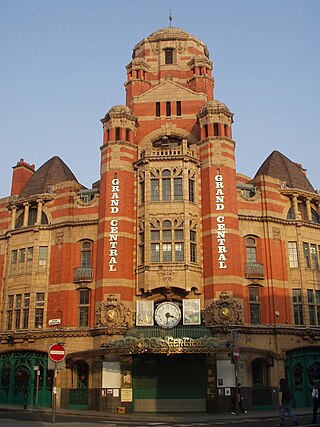
The Grand Central Hall is on 35 Renshaw Street, Liverpool, England. It is now the site of the Liverpool Grand Central Hotel, Hall and Grand Bazaar Food Hall. The building is recorded in the National Heritage List for England as a designated Grade II listed building.
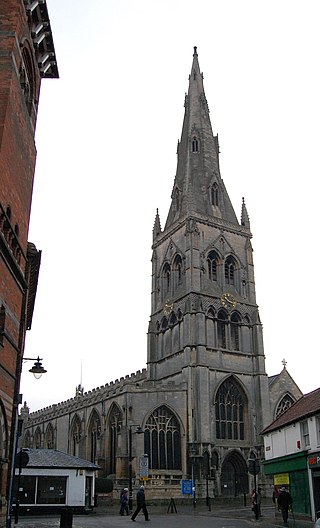
St Mary Magdalene Church, Newark-on-Trent is the parish church of Newark-on-Trent in Nottinghamshire, England. It is dedicated to Mary Magdalene and is the tallest structure in the town.
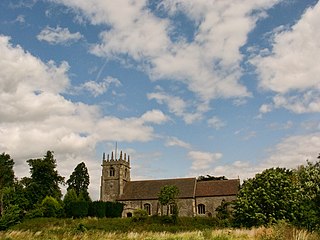
The Church of St. Michael and All Angels, Averham is a parish church in the Church of England in Averham, Nottinghamshire.

Charles I of England left Oxford on 27 April 1646 and travelled by a circuitous route through enemy-held territory to arrive at the Scottish army camp located close to Southwell near Newark-on-Trent on 5 May 1646. He undertook this journey because military Royalism was all but defeated. It was only a matter of days before Oxford would be fully invested and would fall to the English Parliamentarian New Model Army commanded by Lord General Thomas Fairfax. Once fully invested it was unlikely that Charles would be able to leave Oxford without being captured by soldiers of the New Model Army. Charles had been in contact with the various parties that were fielding armies against him seeking a political compromise. In late April he thought that the Scottish Presbyterian party were offering him the most acceptable terms, but to gain their protection and finalise an agreement Charles had to travel to the Scottish army that was besieging the Royalist-held town of Newark. When he had arrived there he was put under close guard in Kelham House.

Staythorpe is a hamlet and civil parish in the Newark and Sherwood district of Nottinghamshire, England.

Newark Town Hall is a municipal building consisting of a town hall, assembly rooms and a market hall in Newark-on-Trent, Nottinghamshire, England. It is a Grade I listed building.
David Howard Nicholas Allenby SSM, was an English clergyman in the Anglican Church and a member of the religious order the Society of the Sacred Mission. He held the position of Bishop of Kuching from 1962 until 1968, and thereafter was an assistant bishop in the Diocese of Worcester.
